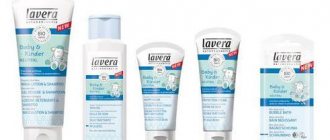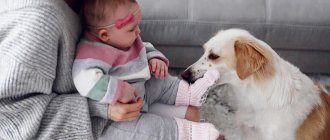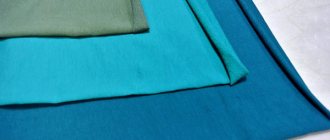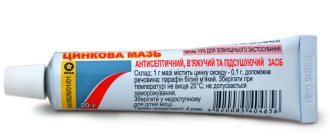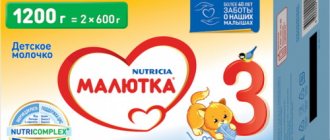Changing a diaper for a newborn is a fairly mundane process, but inexperienced parents who have just brought their baby home from the hospital often have questions about using this hygiene product. Many mothers and fathers at first do not know how to properly put a diaper on a newborn. Choosing a “diaper” with unsuitable patterns for the baby or fastening it incorrectly can harm the baby and cause irritation of his skin. If you put disposable hygiene products on your newborn and tighten the fasteners too tightly, this can rub the baby's legs or compress the vessels that carry blood to the organs.
How are diapers convenient?
Disposable diapers, having entered the infant hygiene market, very quickly gained well-deserved recognition among mothers. Despite the rather high price, they are easy to use and free parents from constant washing.
In the first month, you will use a trial method to select the ideal diaper for your baby, observing the absorbent properties of the products and the reaction of the baby’s skin.
When choosing a diaper, you must first take into account the weight of the child. For convenience, all manufacturers indicate it directly on the product packaging. In the first month, you should be suitable for the smallest series, created for children from 2 to 5 kg. Some “diapers” are equipped with additional amenities in the form of elastic belts or elastic bands, which allow the hygiene product to fit snugly to the baby’s body and prevent bodily fluids from leaking. To prevent the skin of a newborn from becoming inflamed from contact with the product, sometimes manufacturers treat their inner surface with special anti-inflammatory compounds. You can read about how and which diaper to choose here.
When should you use adult diapers?
When a person is forced to remain in bed continuously due to a permanent or temporary illness, the use of special hygiene products helps to maintain cleanliness and create comfort for the patient. It is advisable to wear absorbent diapers for an adult:
- for strokes and myocardial infarction;
- fractures and other injuries of the limbs, pelvic bones;
- tumors and injuries of the head or spine leading to motor dysfunction;
- operations on abdominal or gynecological organs;
- incontinence;
- diseases of the rectum.
A diaper allows an adult bedridden patient to perform natural physiological needs as needed. This is especially true when there is no constant supervision of a nurse caring for the patient.
Algorithm for putting on a diaper
The speed and correctness of the procedure is important. The comfort of the patient and the cleanliness of bed linen depend on them. Instructions can be found on the packaging of hygiene products. The general algorithm looks like this:
- remove the diaper from the pack, straighten all its parts, smooth out the folds, stretch slightly;
- put the patient on his side, bending his knees;
- fold the product and pass it between slightly spread legs, closing the crotch - putting it on should start from the front, pushing the diaper back and straightening the back;
- turn the patient on his back and align the diaper on his stomach so that there are minimal creases;
- the edges of the product should fit snugly to the body, this will help to avoid leakage; after making sure there is a sufficient fit, you should fix the diaper with Velcro - first with the lower ones, in order to wrap the legs more tightly, then with the upper ones.
Figure 1 - Scheme for putting on a diaper
For a patient who is able to stand, using handrails or independently, putting on a diaper is easier. However, this must be done according to a similar scheme.
Frequency of changing diapers
When properly putting on a diaper for an adult, it is important not to forget about timely replacement of the disposable hygiene product. Recommended frequency of procedure:
- after each bowel movement;
- every 3–4 hours with frequent urination;
- at least 2-3 times a day with normal urination.
There are diapers for adults that can absorb up to 4000 ml of liquid. They are changed less often. However, during the day it is better to use products with an absorbency of 1000 ml.
For the replacement procedure you need to prepare the following:
- medical gloves;
- protective diaper or sheet;
- a container of warm water, soap or gel;
- towel;
- container for used diaper;
- cream, talc or other skin care product;
- new diaper.
Procedure for changing a diaper:
- place a diaper on top of the bed to protect it;
- unfasten the Velcro and unscrew the front of the diaper, being careful not to stain the underwear;
- turn the person on his side;
- roll up the bottom of the diaper and carefully pull it out;
- wash the patient’s perineum, inner thighs, buttocks, clearing the skin of traces of feces and urine (instead of water and soap, you can periodically use wet wipes with an antiseptic);
- treat the skin with cream and massage to prevent bedsores.
Diaper selection
It’s not enough to learn how to use diapers for adults; you also need to know how to choose them. There are several parameters to pay attention to.
Figure 2 - When choosing a diaper, it is important to consider several factors
- Material. It should be soft, hypoallergenic, hygroscopic, breathable. So-called breathable products resist the appearance of diaper rash. Only the outer layer should be waterproof.
- Availability of clamps. It is convenient to use Velcro, which allows you to secure the diaper more tightly to the body.
- Size. It does not affect the level of absorption, but determines the suitability of the products to the patient’s hips and waist. Large sizes should only be chosen for large or obese figures. Otherwise, urine and feces will leak onto the bedding.
- Filling indicator. The presence of a strip or inscription that changes color when the diaper is filled helps determine the need for replacement.
Figure 3 — Packaging of diapers for adults
- Floor. A woman needs flatter models of diapers, a man needs a special insert.
- Design features. They must be taken into account if diapers are used for incontinence. For active people, it is important that the product is invisible under clothing.
- Reliability. To eliminate the risk of leakage, it is better to use multi-layer products or with additional liners.
- Quantity per pack. Diapers can be sold in packs of 30 pcs. This is convenient if hygiene products need to be changed frequently. And it is profitable, since in large packs the cost per unit is always lower.
Sources
- https://www.Huggies.ru/library/uhod-za-mladentsem/gigiena/kak-pravilno-nadevat-podguznik
- https://lisa.ru/moy-rebenok/635532-kak-pravilno-nadevat-podguznik-novorozhdennomu-instrukciya-dlya-nachinayushchih-mam-i-pap/
- https://www.colady.ru/kak-odet-pampers-na-malysha-pravilno-podrobnaya-instrukciya-dlya-roditelej.html
- https://o-krohe.ru/podguzniki/kak-pravilno-menyat/
- https://online-care.ru/polezye-sovety/kak-pravilno-nadevat-pampers-na-vzroslogo/
[collapse]
When should you change a diaper?
Your baby's diaper needs to be changed when he has had a bowel movement, or if the diaper looks heavy and the skin underneath has become wet. No matter how much manufacturers praise their products, they often still do not allow the newborn’s skin to breathe. Therefore, it is necessary to change the “diaper” not only if it is completely filled, but also after the child has worn it for 3-4 hours . Such measures, although they will increase the consumption of diapers, will allow your baby to feel more comfortable.
How many diapers do you need?
The average consumption of diapers with constant use, according to reviews from mothers, is about 8 pieces per day (this is about 120 “diapers” per month). The frequency of changing these hygiene products varies depending on how often the newborn is fed breast milk (this determines how many times the baby will pee, since this happens during meals in the first month of life). The nature of your stool also affects how many diapers you need per day or month - your baby may suffer from constipation or, conversely, be prone to diarrhea.
You can reduce the consumption of diapers if you dress your baby in these hygiene products only for walks and trips to the pediatrician. Many mothers save significantly on expensive disposable “diapers” by using gauze or flannel products during sleep, which can be washed and reused as often as necessary.
Over time, you will decide how many diapers your baby needs, how often they need to be changed, and when you can avoid using them to save money.
Preparatory procedures
Before putting a diaper on your newborn, you need to prepare:
- cover the place where you plan to change the baby’s diaper with a sterile diaper; it would be correct to place an oilcloth under it;
- prepare the hygiene products you plan to use: wet wipes, powder or cream;
- if the baby pooped, and you don’t trust wet wipes, prepare a towel and wash the baby in the bathroom ( in order not to introduce infection into the genital tract of girls, they must be washed correctly, moving your hand from the stomach to the butt );
- The baby’s clean skin must either be dried with powder if it is damp, or moisturized with cream if it is dry and flaky;
- allow the newborn’s body to “breathe” a little before changing the diaper, and take care of the diaper yourself;
- Children often pee while in a diaper, so the boy’s genitals should be covered with a napkin for a while.
Is there a difference in diapers for boys and girls?
On supermarket shelves there are diapers for boys and girls. What is the difference? While the child is small, there are no differences, but for older children, the developers took into account the peculiarities of anatomy. In girls' products, the absorbent material is located at the back and in the middle of the diaper. In models for boys, the absorbent is sealed at the front. The features of putting on a boy or a girl are not fundamentally different. The main thing is not to irritate the delicate skin.
The hygiene of boys and girls is different. Both of them are washed with warm water without potassium permanganate and mainly without soap (soap should be used only when the baby has pooped). But if the direction when washing the boy is not significant, the girl is washed from the tummy to the butt to avoid feces getting into the genitals and causing infection. When washing the boy, do not try to push back the foreskin. When carrying out hygiene procedures for a girl, do not wash away the natural lubricant; it performs a protective function. Only the groin folds can be lubricated with cream.
How to change a diaper
- Open the product and straighten the gathers and folds on it, place it near the baby with the inside without drawings up and the narrow side towards you, the latter is the “front”.
- Take the baby by both ankles with one hand and slightly pull them up, the baby’s butt will rise.
- Insert the straightened diaper into the gap formed with the other hand, so that the newborn’s butt rests on the wide part of it, and the Velcro is on the sides of the baby.
- Pull the “front” of the diaper towards you and up, and then apply it to the newborn’s tummy and straighten it (if your umbilical wound has not yet healed, turn the top edge of the “diaper” inward so that it does not touch it).
- Grab the Velcro strips and, pulling slightly until the diaper fits snugly, fasten them to the top front of the diaper on one side and the other.
- Check the tight fit of the product to the baby’s body - your finger should fit between them.
- Straighten the folds of the diaper around the newborn's legs, since the gathered elastic bands often rub the baby's delicate skin, and physiological fluids can leak through them.
What things do you need to prepare to put on a diaper for a newborn?
When your baby needs a diaper change, you can't just spring into action. There must be on-site preparation. Your first task is to gather the things you need, so have them on your list.
Clean diapers
Before changing dirty diapers, you should always have a pair of fresh ones nearby.
Wipes, washcloths, or clean cotton balls
For newborns under one month of age, use warm water and cotton balls to clean the baby. You can use a washcloth later to dry your baby. For other older babies, wet wipes are a good choice.
Clean diapers
If you use cloth diapers, then prepare clean diapers in advance.
Diaper changing area
You must have a place for your child to change clothes. These stations save time and energy from having to run to the baby's room every time for a quick diaper change. The place should stock new diapers, wipes, creams and wipes to make changing diapers an easy task.
Ointment to combat diaper rash
Diaper rashes should be taken very seriously. The rash can be quite painful for the child, affecting the child's behavior. Creams create a barrier between the delicate lower part and irritating skin, giving comfort to the baby. If your child develops a rash, do not use lotions, powder, or baby oil. Using ointments for diaper rash will do this task for you.
Consider the following diaper brands:
LIBERO
LOVULAR
Eco by Naty
P ampers premium care or P ampers active baby dry
Pure Protection
By go
Sun and moon
Huggies elite soft
Setting up a distraction
Place some toys, a music box or any other things within the baby's eye line that will keep the baby busy while you change the diaper. Babies have a habit of squirming during diaper changes, so distraction is important.
Correct use of diapers
- try to change “diapers” every 2-3 hours, even if they are not full, this way you will prevent the baby from overheating and his skin from becoming inflamed, although this will increase the consumption of diapers;
- between changing clothes, be sure to allow the newborn’s genitals to “breathe” as much as possible;
- monitor the reaction of your baby's skin to different brands of diapers to prevent various inflammations - if it is red, covered in a rash, chafed or always wet, try products from a different manufacturer;
- If the newborn is sick and has a fever, it is better to refrain from using “diapers” for the period of illness, as they can cause local overheating.
- do not buy diapers for future use - the baby grows very quickly, and a month’s supply of “diapers” purchased at a discount can quickly become too small for him.


